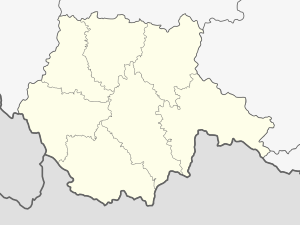Rožmberk Castle
| Rožmberk Castle | ||
|---|---|---|
| Creation time : | 13th Century | |
| Standing position : | Noble | |
| Place: | Rožmberk nad Vltavou | |
| Geographical location | 48 ° 39 '25 " N , 14 ° 22' 10" E | |
|
|
||
The Rožmberk (German Rosenberg ) is located 20 kilometers south of Cesky Krumlov (Cesky Krumlov) , on an elongated rocky promontory above the river Vltava . In 2001, the site, which has been a listed building since 1958, was declared a national cultural monument of the Czech Republic .
history
The Upper Castle was built after 1225 by the Witigonen Witiko von Prčice and Blankenberg or his son Wok von Rosenberg , who was first mentioned in 1250 in a document from King Wenceslaus I as "Woko de Rosenberch". Although his father Witiko von Prčice and Blankenberg is considered to be the founder of the Rosenberg family branch , Wok was the first to use the predicate "von Rosenberg" derived from the castle name. Wok's son Heinrich I von Rosenberg also resided at the Rosenburg, but moved his seat to the Krumau Castle in 1302 after the extinction of the Witigon family branch of the Lords of Krumau , whose possessions had passed to the Rosenbergs . Nevertheless, Rosenberg Castle was still used by the Rosenbergers. The administration was entrusted to a burgrave, who also had to organize the permanent military garrison and was responsible for the regular opening and closing of the castle gates.
The Lower Castle , first mentioned in a document in 1262, was expanded from 1330–1340 under Peter I von Rosenberg . In 1420 Ulrich II. Von Rosenberg pledged the castle and the Rosenberg rule to the Lords of Walsee , who were followed after 1460 by the Lords of Lobkowitz . After that it must have come back to the Rosenbergs, since after 1550 the castle and rule Rosenberg were administered by Jan Zrinski, a nephew of Peter Wok von Rosenberg . Jan Zrinski was a son of Peter Wok's sister Eva and Nikola Šubić Zrinski . During this time, the architect Baldassare Maggi converted the Lower Castle into a Renaissance castle. After the death of Peter Wok von Rosenberg in 1611, the Lords of Schwanberg were the new owners from 1612 . Since Peter von Schwanberg was involved in the Bohemian uprising in 1618 , Rosenberg Castle was captured by the imperial army under Field Marshal Karl Bonaventura Bucquoy in 1619 . Out of gratitude, Emperor Ferdinand gave him the castle in 1620. It remained in the possession of the Counts Buquoy until they were expropriated and expelled in 1945.

Under the Count Buquoy, the Lower Castle was rebuilt in the neo-Gothic style in 1840–1857 . Subsequently, the anglophile Georg Johann Heinrich von Buquoy refurbished numerous rooms, including the cross gallery, the armory and the Rosenberg rooms. The family gallery can also be traced back to him.
building
The Rosenberg Castle complex consists of an Upper Castle and a Lower Castle .
The Gothic tower called Jakobínka has been preserved from the upper castle from the 13th century. The commercial and residential buildings surrounding the round tower date from the 19th century.
The younger, lower castle was expanded into a Renaissance castle in the 16th century and rebuilt in a neo-Gothic style in the 19th century. The almost rectangular inner courtyard is closed in the southeast by a crenellated tower with a square floor plan.
literature
- Joachim Bahlcke , Winfried Eberhard, Miloslav Polívka (eds.): Handbook of historical places . Volume: Bohemia and Moravia (= Kröner's pocket edition . Volume 329). Kröner, Stuttgart 1998, ISBN 3-520-32901-8 , pp. 524-525.
- Eduard Bažant, Jan Nepomuk Berwid-Buquoy: Rosenberg Castle. A historical-political consideration. BI-HI Verlag, Berlin 1987, ISBN 3-924933-04-9 .
- Wilhelm-Christian Erasmus (Red.): Castles, monasteries and palaces in the Waldviertel, Danube region, South Bohemia, Vysocina and South Moravia regions. Destination Waldviertel, Zwettl 2007, ISBN 978-3-9502262-2-5 , p. 97 f.
Web links
- Rožmberk Castle. Official Web Presentation. Official homepage on hrad-rozmberk.cz (English, Czech).
Individual evidence
- ↑ Hrad Rožmberk nad Vltavou ÚSKP 21001 / 3-1393 in the monument catalog pamatkovykatalog.cz (Czech).
- ↑ a b c d e Rožmberk nad Vltavou Castle . In: Online encyclopedia encyklopedie.ckrumlov.cz about Krummau .
- ^ Burgrave of Rožmberk Castle . In: Online encyclopedia encyklopedie.ckrumlov.cz about Krummau (description in German).

